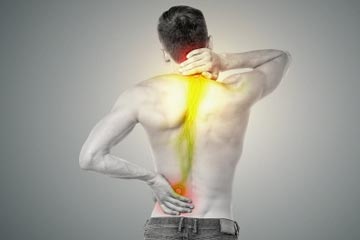
The horror of desk job workers, the nightmare of housewives, the dread of old age—Low back pain can hit almost anyone and at any time, really sapping the life out of you. Let’s take a closer look at this condition.
Some years back I myself experienced an acute episode of low back pain. Lasting, for about half a month it really made those days hell. The pain was too intense to allow me any sort of activity. Though a proper diagnosis wasn’t set up, I believe it might have been a result of spending too much time sitting on a chair before the books. (P.S.: The episode occurred right after 2-3 month long stressful examination period). In the end what worked me were a combination of painkillers, with appropriate exercises and ultrasound therapy from the physiotherapist.
Low back pain—Introduction
As the name suggests low back pain is the spectrum of conditions that leads to pain in the structures present at the lower back. These structures can be muscles, tendons, or any other soft tissues, nerves or nerve roots travelling through the area, various joints, and spinal discs. The pain at times may radiate or refer to other parts of body too.
The severity of pain depends on the underlying cause, for example the pain originating from a muscle strain might force you to see a doctor immediately, while that from senile disc may lead to a chronic, mild and recurrent pain.
Thus, it’s mandatory to accurately diagnose the underlying condition for treating the low back pain.
Low back pain—Causes
- Injuries sustained from overuse, strain, or external hurts like while trying to lift something heavy, or reaching out for something too far, twisting while dancing or incurred during an accident.
- Aging is an important cause of low back pain. The senile discs are not only prone to external injuries but also degenerative processes can cause low back pain.
- Disc herniation because of any reason might present as low back pain.
- Arthritis is another important cause of low back pain, more frequent with increasing age.
- Chronic illnesses
- Congenital spine problems
- Compression fractures can also lead to low back pain.
At times it not really possible even after extensive diagnosis methods to accurately diagnose the underlying cause.
Low back pain—Diagnosis
Generally, the diagnosis is made from the patient’s history and physical examination. The doctor should ask questions including symptoms details, personal details, past and occupation history. Low back pain is often related to occupation, thus the accurate work details are important.
Although, the doctor should be able to make an accurate diagnosis based on history and thorough physical examination X-rays, CT scans and MRIs can be used to confirm the underlying cause.
- X-ray: X-ray can used to rule out fractures, tumors, or spinal instabilities.
- CT scan: The cross-sectional images of the spinal disc and vertebrae obtained from the CT scan can be utilized in looking for spinal stenosis and herniated discs.
- MRI scan: They are valuable in assessing problems with nerve roots and lumbar discs. They are also helpful in ruling out spinal tumors or infections.
- Myelogram: A contrast dye is injected to highlight the spine prior to CT scan or x-rays. It helps in ruling out problems associated with the spine, spinal cord or nerve roots.
How to treat low back pain?
The treatment depends upon the underlying cause of the pain. In most cases the pain would be relieved by first aid including mild exercises and over-the-counter painkillers along with rest. Even walking is known to be of great help during and after an episode of low back pain. Walking not only acts as a light exercise for the back, it helps the blood flow and strengthens the muscles.
You must consult your doctor and/or a physiotherapist for recommending the right exercises. The exercises tend to strengthen the back muscles, thereby improving posture and balance.
In other cases where regular pain medication and exercise doesn’t help additional methods might be employed including spinal manipulations, as posture straps, acupuncture or massage.
Heat or ice packs also helps in low back pain by reducing inflammation. Although both methods are beneficial alone, using them alternately can significantly improve the results. In case the low back pain isn’t treated by the above mentioned treatments other mode of treatments are:
Epidural Steroid Injections directly injects steroids in the painful areas to reduce inflammation, thus, pain. Although this method doesn’t treat the problem, it relieves the patients from pain, hence allowing them to continue their normal life.
Surgery might be required when no medical methods have worked as expected. Surgeries (microdisectomy and laminectomy) have shown good results in pain related to sciatica by relieving the compression. Fusion surgery is useful in pain related to painful motion segment.








